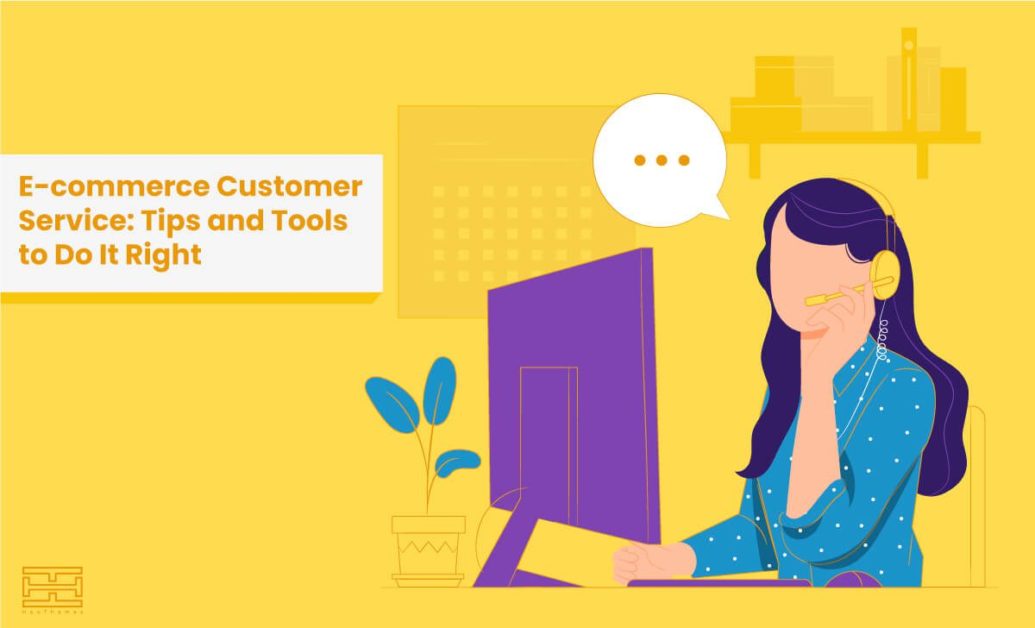In the modern online business sphere, customer service is the center around which client interactions revolve. Poor customer service interactions can tarnish a business and lead to disastrous social media crises. Strengthening a company’s eCommerce customer service should be at the top of its priority for business success.
E-commerce customer service provides a framework for online buyers. Furthermore, it plays a significant part in evaluating various channels that clients rely on to ensure an immediate response. Incorporating good customer service while leveraging the appropriate tools will help your organization flourish. But that’s not all. A satisfactory customer service, the right tools, a detailed customer journey map, and the optimal conversion rate optimization strategies can significantly skyrocket your business.
Whether you’re a veteran or just starting a business, there’s always room for improvement. In this article, we’ll go over several tactics for assisting your organization in providing outstanding e-commerce customer care.
E-commerce Customer Service Tip #1: Maximize the Benefits of Self-Service
As reported by Harvard Business Review, 81 % of consumers prefer to attempt to address their problems or get answers to their questions on their own before contacting customer service. Time and accessibility are critical factors, and well-crafted self-service options provide fast and easy solutions.
Some of the main benefits are:
- They are available 24 hours a day, seven days a week.
- They are less expensive than hiring personal assistance.
- They enable employees to be more productive by avoiding repetitively answering basic questions and focusing on more difficult customer issues.
Shinesty’s director of experience, Antonio King, has demonstrated the effect of exceptional customer service on their profit by tracking consumer engagement with customer lifetime value.
King explained that they’ve concentrated on client efforts rather than client satisfaction since a low effort experience better determines customer trust. He also stated that linking customer loyalty with customer service had been an awe-inspiring step, to the point of recognizing ways to continue to reduce the client’s effort.
It is necessary to keep in mind that no self-service technology is one-time-setting and requires frequent updates. Nevertheless, it’s worth it to put in the time. Remember to make all of your self-service tools simply accessible and mobile-friendly.
E-commerce Customer Service Tip #2: Implement a Knowledge Base
About the previous step, a carefully written and easily accessible knowledge base should be the foundation of any self-service approach.
What exactly is a knowledge base? It’s a centralized repository that contains common questions, tutorials, and helpdesk guidelines. Its goal is to make it simple for people to solve problems without having to ask for assistance.
External or internal audiences can both benefit from knowledge bases. In some cases, businesses prepare knowledge bases useful to anyone engaged in their industry, not just their clients.
Also, a knowledge base can provide valuable insights. If you choose a knowledge base tool that includes reporting features, you’ll be able to see what users are searching and discovering, words they use to search, any disparities in your knowledge base, etc. You can use that data to improve the content of your knowledge base, as well as your services or products.
E-commerce Customer Service Tip #3: Provide Proactive Customer Service
Customers may be unaware of your help and care aspects while checking out your website. They could have doubts but be unsure of where to direct them. Alternatively, they may decide that contacting support is too time-consuming and relocate to a rival company. Even if your website has service features, it’s essential to inform your customers about them.
Rely on popular content management systems like WordPress to design your website and use it to create high-converting landing pages to hook visitors easier. Doing so will allow you to have more control over your website’s elements and content.
Additionally, create CTAs on your website to utilize proactive customer support. Clarify where visitors can submit service requests and include FAQs about what to expect from your contact center.
Establish a pop-up copy that directs your guest’s focus to the live chat dashboard. This will lead consumers to use your customer service functionalities, allowing you to interact and delight them.
The team at gaming platform Soltiaired, for example, found that while they had a knowledge base, adding accessible customer support further improved their customer satisfaction rate and subsequently user retention.
E-commerce Customer Service Tip #4: Develop a Multichannel Strategy
The majority of online sellers now offer their services on various platforms. Customers can send their questions through those channels, as well as via email or social media. The list could go on and on.
Whether you’re an online or a traditional retailer, people expect an omnichannel presence from you. According to a recent study, most in-store consumers would instead look through reviews on their mobile than speak with a salesperson.
Maintaining a wide range of communication choices can be difficult for any company. This may impair your team’s responsiveness, and many online shops may not prepare different operatives for multiple platforms.
So, besides obviously following the campaign results, the best course of action is to ask your clients directly. You could send them a questionnaire and ask them, “Which customer service channels do you opt for?” The answers will help you gain a better comprehension of your customers’ tastes.
E-commerce Customer Service Tip #5: Reduce Your Response Time
People prefer online shopping because it is quick and easy. They can instantly make comparisons and have items delivered to their front door. Furthermore, If a customer has a question, they expect a prompt response. Those who came to your site to make a quick purchase don’t wish to wait for answers.
As reported by Statista, “lack of speed” is the second most common customer service complaint, right behind “lack of effectiveness.” Enabling customers to contact your customer service team via various channels is insufficient. The balance of speed and accessibility is essential for a high-performing team.
With a perfectly functioning omnichannel customer service scheme in place, you’ll have the ability to serve clients with a steady level of quality in a short time throughout multiple channels.
E-commerce Customer Service Tip #6: Use Social Media to Reach Out to Customers
Buyers are using social media more than ever before. They are uploading pictures from their vacations or dinner parties and interactions with their preferred brands.
The e-commerce customer service strategy without social media is highly flawed. Top social media networks such as Facebook, Instagram, Twitter, etc., have evolved into powerful tools for assisting current customers and attracting new ones.
Hire a Social Media Manager to monitor what clients have to say about your company on social media. Addressing their worries on a public platform will assist your company in establishing a solid brand image.
Furthermore, sending clients anniversary or birthday wishes and tagging them on social media can boost customer loyalty. You can also organize events and reward customers with personalized gifts or coupon codes as part of your social marketing approach.
E-commerce Customer Service Tip #6: Offer Live Chat
The entire customer experience revolves around this idea: find a product quickly, buy it in seconds, and have it delivered to your door. Meet this customer expectation in your live chat channel model. Consumers get immediate answers to their questions, and you gain customers’ trust through social interactions.
If you haven’t tried live chat yet, you’ll be amazed by what it can do. It can assist you with revenue inquiries to handling invoices, delivery questions, and post-sales assistance. Live chat can help team members be more constructive and reliable in their responses by utilizing pre-written built-in functions within the experience.
Fire-chats can also be a gold mine of opportunities, so review your chat transcripts to see if there’s any chance to respond to client feedback or follow up on the matter brought up during the chat.
E-commerce Customer Service Tip #7: Don’t Make Customers Repeat Themselves
As reported by HubSpot Research, two-thirds of shoppers say waiting on hold or explaining the same information to the different representatives is the most aggravating part of getting customer support.
To assist customers quickly, your employees require a centralized communication infrastructure. Buyers want this as well, though they experience it in different ways, such as describing their issues to multiple people at your company or waiting on hold. If they’ve made it clear once, it’s up to you to keep track of it in a way that’s easy to reach to any customer-facing worker who might be involved in resolving their problem.
E-commerce Customer Service Tip #8: Track the Most Important Through Smart Reporting
There’s a lot to monitor in e-commerce from a business standpoint. All of this can be reduced to a few consumer-related key performance indicators in your helpdesk. Customer happiness, overall conversations per day, and tag insights are essential metrics to track in e-commerce.
With a detailed knowledge base and internet site, you can effectively reduce interactions. Test to see whether customized answers or minimizing response time can increase customer satisfaction. Encourage your team to tag hot topics as they come up so you can make changes to the product or draft a new knowledge base document.
E-commerce Customer Service Tip #9: Act Upon Client Feedback
Sometimes, companies fail to provide excellent customer service because they do not fully comprehend what it contains. They don’t understand the expectations and domains of their target audience.
For any e-commerce business, customer feedback is priceless. Your consumers have a distinct viewpoint on your goods and services. They can point out any problems you’re having or tell you where you’re making progress.
The first step towards improving customer service is to seek feedback. The second and most essential step is to take action. When people tell you about issues they’ve had, take care of them. Then demonstrate that you’ve done so to both those who disclosed them and others.
Also, whatever your customers say, you must respond politely and positively. This is a crucial aspect of e-commerce customer service that you must master if you want to increase your sales.
E-commerce Customer Service Tip #10: Put Yourself in Your Customer’s Shoes
Take some time to see what it’s like to be your client. If it’s challenging to find information or your personnel is disrespectful, your consumers will probably have a bad experience. Your customer support can be fully automated by setting up a call center automation and be the most straightforward platform to manage for your employees, but if it’s stressful for clients, you’ll have problems.
Best E-Commerce Customer Service Tools
Once you’ve chosen the best e-commerce platform for your business needs, it’s time to decide on the most suitable e-commerce customer service tool. There are plenty of options, and most of them cover all the crucial parts of customer service, but we’ve picked out a few most popular and widely used.
LiveHelpNow is an omnichannel customer support software that facilitates real-time customer service communications via Live Chat, ChatBot, SMS/Text, Email, Ticketing, and Facebook Messenger. The platform also allows customers to help themselves with a self-help knowledge base and a support portal that monitors past and present service inquiries.
However, before reading through the list of tools, we must remind you again that tools aren’t merely enough. You must incorporate many elements to deliver the best E-commerce customer service possible, namely using a service for website visitor tracking.
Kayako: Kayako is a customer support application with e-commerce-specific features. For instance, it has Facebook and Twitter toolkits that help customer service representatives oversee social media queries. There’s also a shared inbox element, which collects all user requests in one place. That way, representatives can stay on top of all customer encounters using a single interface.
Hubspot Service Hub: Hubspot is frequently the ruler of all marketing assets, tools, and assessments. Their Service Hub is a one-stop-shop for customer care and a fantastic piece of software. It can be incorporated into the Hubspot CRM and the rest of the Hubspot software. Even if you don’t have it, the apparent advantage of using Hubspot’s Hub is that you’ll have entry to a whole field of information from a single dashboard, saving you time when making decisions.
Zendesk: Zendesk has become the first association to online customer service for many companies in recent years. It’s used by some of the most well-known tech corporations, such as Uber and Shopify, and it offers a comprehensive customer support solution for every stage of the buying process.
Salesforce Commerce Cloud: If you’re seeking a package deal to ensure you’re reaching your clients and providing precisely what they expect, SF Commerce Cloud is the tool for you. This platform is used by some of the world’s most well-known retailers (such as Callaway and Ethan Allen) to provide a flawless buying experience across all channels. It can be used for various tasks, including announcing new brand sites, acquiring customer insights, and combining with one of the best CRMs available.
Gorgias: The overlap between customer support and sales in e-commerce brings numerous possibilities to gain fresh, loyal consumers. Gorgias primarily accomplishes this via simple assimilation with three of the most used e-commerce platforms available: Shopify, Magento, and BigCommerce.
Engati: is a chatbot platform that provides our customers with the proper structure to build robust chatbots. You can create the best chatbot for websites without the need for any coding or programming.
ViiBE: ViiBE is a visual assistance technology without download and integrated into all CRMs dedicated to technical support centers and pre/after-sale processes. It promises the best remote diagnosis thanks to living video streams, AR, and collaborative tools. ViiBE’s solutions help companies reduce costs and CO2 emissions while increasing customer satisfaction and NPS.
Over to You
The level of your customer cares heavily influences the health of your e-commerce. As a result, it is imperative to have a strategy to ensure that customers have an incredible shopping journey.
With well-adjusted e-commerce customer service, you can strive to enrich the experience you deliver to your clients while building a solid brand reputation.

![Read more about the article 50 Best Behavioral Analytics Tools in 2023 [Definitive List]](https://www.hoothemes.com/wp-content/uploads/2022/10/50-Best-Behavioral-Analytics-Tools-in-2022-Definitive-List-300x157.png)
![Read more about the article What is Persona Mapping? [+How to Create a Persona Map in 2022]](https://www.hoothemes.com/wp-content/uploads/2021/10/Want-To-Be-Amazing-At-Persona-Mapping-Hereu2019s-How-300x182.jpg)






